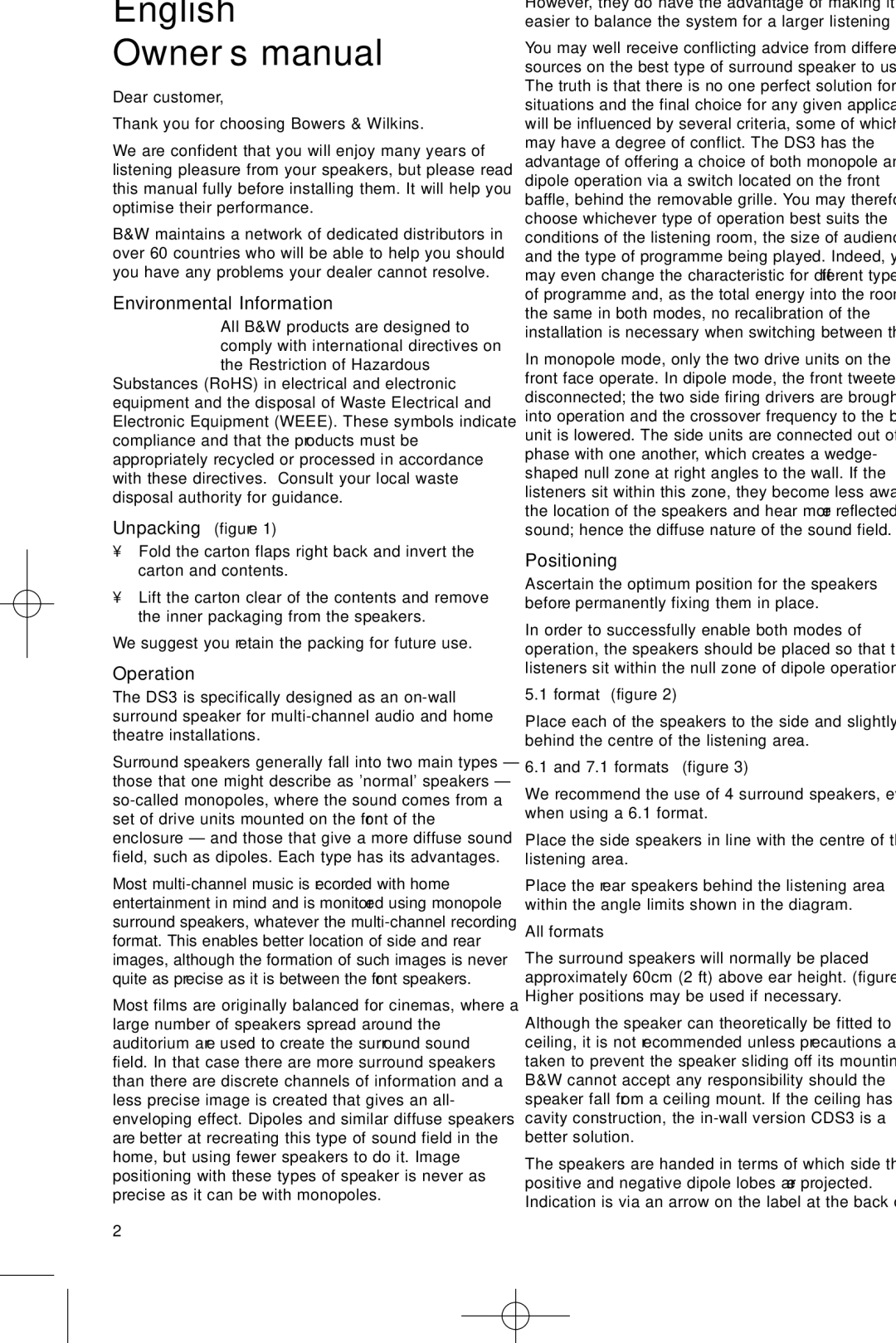English
Owner’s manual
Dear customer,
Thank you for choosing Bowers & Wilkins.
We are confident that you will enjoy many years of listening pleasure from your speakers, but please read this manual fully before installing them. It will help you optimise their performance.
B&W maintains a network of dedicated distributors in over 60 countries who will be able to help you should you have any problems your dealer cannot resolve.
Environmental Information
All B&W products are designed to
comply with international directives on the Restriction of Hazardous
Substances (RoHS) in electrical and electronic equipment and the disposal of Waste Electrical and Electronic Equipment (WEEE). These symbols indicate compliance and that the products must be appropriately recycled or processed in accordance with these directives. Consult your local waste disposal authority for guidance.
Unpacking (figure 1)
•Fold the carton flaps right back and invert the carton and contents.
•Lift the carton clear of the contents and remove the inner packaging from the speakers.
We suggest you retain the packing for future use.
Operation
The DS3 is specifically designed as an on-wall surround speaker for multi-channel audio and home theatre installations.
Surround speakers generally fall into two main types – those that one might describe as 'normal' speakers – so-called monopoles, where the sound comes from a set of drive units mounted on the front of the enclosure – and those that give a more diffuse sound field, such as dipoles. Each type has its advantages.
Most multi-channel music is recorded with home entertainment in mind and is monitored using monopole surround speakers, whatever the multi-channel recording format. This enables better location of side and rear images, although the formation of such images is never quite as precise as it is between the front speakers.
Most films are originally balanced for cinemas, where a large number of speakers spread around the auditorium are used to create the surround sound field. In that case there are more surround speakers than there are discrete channels of information and a less precise image is created that gives an all- enveloping effect. Dipoles and similar diffuse speakers are better at recreating this type of sound field in the home, but using fewer speakers to do it. Image positioning with these types of speaker is never as precise as it can be with monopoles.
However, they do have the advantage of making it easier to balance the system for a larger listening area.
You may well receive conflicting advice from different sources on the best type of surround speaker to use. The truth is that there is no one perfect solution for all situations and the final choice for any given application will be influenced by several criteria, some of which may have a degree of conflict. The DS3 has the advantage of offering a choice of both monopole and dipole operation via a switch located on the front baffle, behind the removable grille. You may therefore choose whichever type of operation best suits the conditions of the listening room, the size of audience and the type of programme being played. Indeed, you may even change the characteristic for different types of programme and, as the total energy into the room is the same in both modes, no recalibration of the installation is necessary when switching between them.
In monopole mode, only the two drive units on the front face operate. In dipole mode, the front tweeter is disconnected; the two side firing drivers are brought into operation and the crossover frequency to the bass unit is lowered. The side units are connected out of phase with one another, which creates a wedge- shaped null zone at right angles to the wall. If the listeners sit within this zone, they become less aware of the location of the speakers and hear more reflected sound; hence the diffuse nature of the sound field.
Positioning
Ascertain the optimum position for the speakers before permanently fixing them in place.
In order to successfully enable both modes of operation, the speakers should be placed so that the listeners sit within the null zone of dipole operation.
5.1format (figure 2)
Place each of the speakers to the side and slightly behind the centre of the listening area.
6.1 and 7.1 formats (figure 3)
We recommend the use of 4 surround speakers, even when using a 6.1 format.
Place the side speakers in line with the centre of the listening area.
Place the rear speakers behind the listening area within the angle limits shown in the diagram.
All formats
The surround speakers will normally be placed approximately 60cm (2 ft) above ear height. (figure 4) Higher positions may be used if necessary.
Although the speaker can theoretically be fitted to the ceiling, it is not recommended unless precautions are taken to prevent the speaker sliding off its mounting. B&W cannot accept any responsibility should the speaker fall from a ceiling mount. If the ceiling has a cavity construction, the in-wall version CDS3 is a better solution.
The speakers are handed in terms of which side the positive and negative dipole lobes are projected. Indication is via an arrow on the label at the back of

